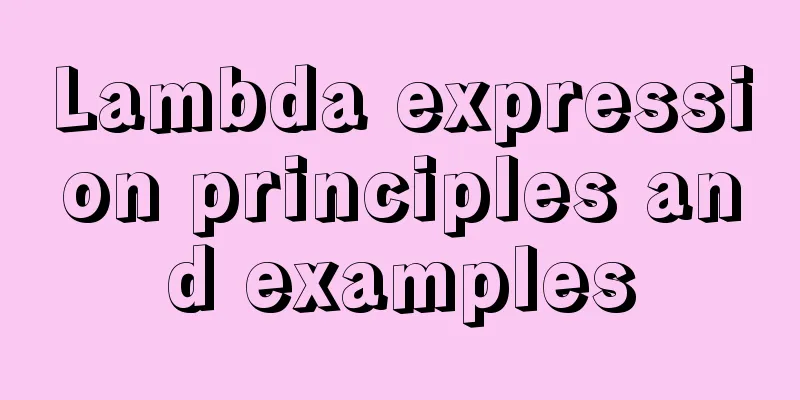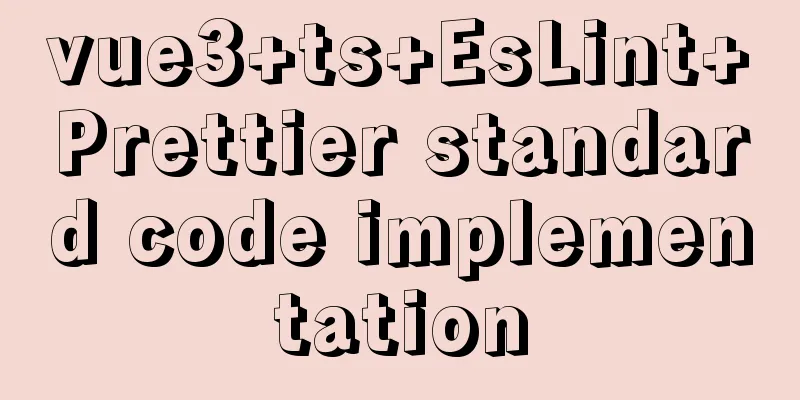Lambda expression principles and examples

Lambda Expressions Lambda expressions, also known as closures, are the most important new feature that drove the release of Java 8. 1. Demand AnalysisCreate a new thread and specify the task to be performed by the thread
public static void main(String[] args) {
// Start a new thread new Thread(new Runnable() {
@Override
public void run() {
System.out.println("Code executed in the new thread: "+Thread.currentThread().getName());
}
}).start();
System.out.println("Code in the main thread: " + Thread.currentThread().getName());
}Code Analysis:
2. Lambda Expressions for BeginnersLambda expression is an anonymous function, which can be understood as a piece of code that can be passed new Thread(() -> { System.out.println("New thread Lambda expression..." +Thread.currentThread().getName()); }) The syntax of anonymous inner classes is redundant. After experiencing Lambda expressions, I found that Lambda expressions are a way to simplify anonymous inner classes. 3. Lambda syntax rulesLambda eliminates the object-oriented rules and regulations. The standard format of Lambda consists of three parts:
Format description:
3.1 Lambda Exercise 1Practice Lambda with no parameters and no return value Defining an interface
public interface UserService {
void show();
}
Then create the main method using
public class Demo03Lambda {
public static void main(String[] args) {
goShow(new UserService() {
@Override
public void show() {
System.out.println("show method executed...");
}
});
System.out.println("----------");
goShow(() -> { System.out.println("Lambda show method executed..."); });
}
public static void goShow(UserService userService){
userService.show();
}
}
Output:
3.2 Lambda Exercise 2Complete a Lambda expression case with parameters and return value Creating a Person Object
@Data
@AllArgsConstructor
@NoArgsConstructor
public class Person {
private String name;
private Integer age;
private Integer height;
}
Then we save multiple Person objects in the List collection, and then sort these objects according to age.
public static void main(String[] args) {
List<Person> list = new ArrayList<>();
list.add(new Person("Jay Chou",33,175));
list.add(new Person("Andy Lau",43,185));
list.add(new Person("周星驰",38,177));
list.add(new Person("郭富城",23,170));
Collections.sort(list, new Comparator<Person>() {
@Override
public int compare(Person o1, Person o2) {
return o1.getAge()-o2.getAge();
}
});
for (Person person : list) {
System.out.println(person);
}
}
We found that the second parameter of the sort method is an anonymous inner class of the Comparator interface, and the executed method has parameters and return values, so we can rewrite it as a Lambda expression
public static void main(String[] args) {
List<Person> list = new ArrayList<>();
list.add(new Person("Jay Chou",33,175));
list.add(new Person("Andy Lau",43,185));
list.add(new Person("周星驰",38,177));
list.add(new Person("郭富城",23,170));
/*Collections.sort(list, new Comparator<Person>() {
@Override
public int compare(Person o1, Person o2) {
return o1.getAge()-o2.getAge();
}
});
for (Person person : list) {
System.out.println(person);
}*/
System.out.println("------");
Collections.sort(list,(Person o1,Person o2) -> {
return o1.getAge() - o2.getAge();
});
for (Person person : list) {
System.out.println(person);
}
}
Output
4. @FunctionalInterface annotation@FunctionalInterface is a new functional annotation added in JDK8, indicating that the interface modified by this annotation can only have one abstract method.
/**
* @FunctionalInterface
* This is a functional annotation. The interface modified by this annotation can only declare one abstract method*/
@FunctionalInterface
public interface UserService {
void show();
}
5. The principle of Lambda expressionThe essence of an anonymous inner class is to generate a Class file during compilation. XXXXX$1.class
public class Demo01Lambda {
public static void main(String[] args) {
// Start a new thread new Thread(new Runnable() {
@Override
public void run() {
System.out.println("Code executed in the new thread: "+Thread.currentThread().getName());
}
}).start();
System.out.println("Code in the main thread: " + Thread.currentThread().getName());
System.out.println("---------------");
/*new Thread(() -> { System.out.println("New thread Lambda expression..." +Thread.currentThread().getName()); })
.start();*/
}
}
You can also use the decompilation tool to view the generated code XJad tool to view
static class Demo01Lambda$1
implements Runnable
{
public void run()
{
System.out.println((new StringBuilder()).append("Code executed in the new thread: " ).append(Thread.currentThread().getName()).toString());
}
Demo01Lambda$1()
{
}
}
So what is the principle of Lambda expression? We also use the decompilation tool to check
For class files with Lambda expressions, we use XJad to check errors. At this time, we can use a tool that comes with JDK: javap to disassemble the bytecode. javap -c -p filename.class
The result of disassembly:
E:\workspace\OpenClassWorkSpace\JDK8Demo\target\classes\com\bobo\jdk\lambda>javap -c -p Demo03Lambda.class
Compiled from "Demo03Lambda.java"
public class com.bobo.jdk.lambda.Demo03Lambda {
public com.bobo.jdk.lambda.Demo03Lambda();
Code:
0: aload_0
1: invokespecial #1 // Method java/lang/Object."<init>":()V
4: return
public static void main(java.lang.String[]);
Code:
0: invokedynamic #2, 0 // InvokeDynamic #0:show:()Lcom/bobo/jdk/lambda/service/UserService;
5: invokestatic #3 // Method goShow:(Lcom/bobo/jdk/lambda/service/UserService;)V
8: return
public static void goShow(com.bobo.jdk.lambda.service.UserService);
Code:
0: aload_0
1: invokeinterface #4, 1 // InterfaceMethod com/bobo/jdk/lambda/service/UserService.show:()V
6: return
private static void lambda$main$0();
Code:
0: getstatic #5 // Field java/lang/System.out:Ljava/io/PrintStream;
3: ldc #6 // String Lambda show method executes...
5: invokevirtual #7 // Method java/io/PrintStream.println:(Ljava/lang/String;)V
8: return
}
In this decompiled source code, we see a static method lambda$main$0(). What does this method do? Let's check it out through debugging:
The above effect can be understood as follows:
public class Demo03Lambda {
public static void main(String[] args) {
....
}
private static void lambda$main$0();
System.out.println("Lambda show method executed...");
}
}To understand this more intuitively, we can add -Djdk.internal.lambda.dumpProxyClasses when running. Adding this parameter will output the internal class code to a file Command Execution E:\workspace\OpenClassWorkSpace\JDK8Demo\target\classes>java -Djdk.internal.lambda.dumpProxyClasses com.bobo.jdk.lambda.Demo03Lambda
Decompiled content:
You can see that this anonymous inner class implements the UserService interface and overrides the show() method. In the show method, Demo03Lambda.lambda$main$0() is called, which means the content in Lambda is called.
public class Demo03Lambda {
public static void main(String[] args) {
goShow(new UserService() {
@Override
public void show() {
Demo03Lambda.lambda$main$0();
}
});
System.out.println("----------");
}
public static void goShow(UserService userService){
userService.show();
}
private static void lambda$main$0();
System.out.println("Lambda show method executed...");
}
}
summary: An anonymous inner class will generate a class file when compiled. Lambda expressions form a class when the program runs.
6. Abbreviation of Lambda ExpressionBased on the standard writing of lambda expressions, the rules for using ellipsis are as follows:
public class Demo05Lambda {
public static void main(String[] args) {
goStudent((String name,Integer age)->{
return name+age+" 6666 ...";
});
// Abbreviated form goStudent((name,age)-> name+age+" 6666 ...");
System.out.println("------");
goOrder((String name)->{
System.out.println("--->" + name);
return 666;
});
// Abbreviated notation goOrder(name -> {
System.out.println("--->" + name);
return 666;
});
goOrder(name -> 666);
}
public static void goStudent(StudentService studentService){
studentService.show("张三",22);
}
public static void goOrder(OrderService orderService){
orderService.show("Li Si");
}
}
7. Prerequisites for using Lambda expressionsThe syntax of Lambda expressions is very concise, but Lambda expressions cannot be used casually. There are several conditions that need special attention when using them.
8. Comparison between Lambda and anonymous inner classesComparison between Lambda and anonymous inner classes 1. The required types are different
2. The number of abstract methods is different
3. The implementation principles are different
This is the end of this article about the principles and examples of Lambda expressions. For more information about Lambda expressions, please search for previous articles on 123WORDPRESS.COM or continue to browse the following related articles. I hope you will support 123WORDPRESS.COM in the future! You may also be interested in:
|
>>: MySQL 8.0.18 Installation Configuration Optimization Tutorial
Recommend
How to create a virtual environment using virtualenv under Windows (two ways)
Operating system: windowns10_x64 Python version: ...
Briefly talk about mysql left join inner join
Preface I have been busy developing a cold chain ...
This article will show you the basics of JavaScript: deep copy and shallow copy
Table of contents Shallow copy Deep Copy Replenis...
Detailed explanation of location and rewrite usage in nginx
1. Summary of location usage Location can locate ...
Detailed explanation of using Vue custom tree control
This article shares with you how to use the Vue c...
FlashFXP ftp client software registration cracking method
The download address of FlashFXP is: https://www....
How to check if the firewall is turned off in Linux
1. Service method Check the firewall status: [roo...
Detailed discussion of MySQL stored procedures and stored functions
1 Stored Procedure 1.1 What is a stored procedure...
How the Linux kernel breaks into the process address space and modifies the process memory
Isolation of process address spaces is a notable ...
Linux system to view CPU, machine model, memory and other information
During system maintenance, you may need to check ...
Using streaming queries in MySQL to avoid data OOM
Table of contents 1. Introduction 2. JDBC impleme...
How to run MySQL using docker-compose
Directory Structure . │ .env │ docker-compose.yml...
The relationship between JS constructor and instantiation and prototype introduction
Table of contents 1. Constructor and instantiatio...
CSS Back to Top Code Example
Most websites nowadays have long pages, some are ...
CSS3 realizes draggable Rubik's Cube 3D effect
Mainly used knowledge points: •css3 3d transforma...














